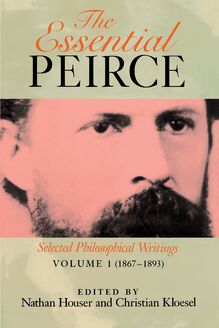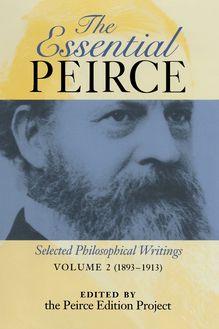The Essential Peirce, Volume 1 , livre ebook
271
pages
English
Ebooks
1992
Vous pourrez modifier la taille du texte de cet ouvrage
Obtenez un accès à la bibliothèque pour le consulter en ligne En savoir plus
Découvre YouScribe en t'inscrivant gratuitement
Découvre YouScribe en t'inscrivant gratuitement
271
pages
English
Ebooks
1992
Vous pourrez modifier la taille du texte de cet ouvrage
Obtenez un accès à la bibliothèque pour le consulter en ligne En savoir plus
Publié par
Date de parution
22 novembre 1992
Nombre de lectures
2
EAN13
9780253007827
Langue
English
Poids de l'ouvrage
3 Mo
Volume I presents twenty-five key texts from the first quarter century of his writing, with a clear introduction and informative headnotes.
" . . . a first-rate edition, which supersedes all other portable Peirces. . . . all the Peirce most people will ever need." —Louis Menand, The New York Review of Books
"The Monist essays are included in the first volume of the compact and welcome Essential Peirce; they are by Peirce's standards quite accessible and splendid in their cosmic scope and assertiveness." —London Review of Books
A convenient two-volume reader's edition makes accessible to students and scholars the most important philosophical papers of the brilliant American thinker Charles Sanders Peirce. This first volume presents twenty-five key texts from the first quarter century of his writing, with a clear introduction and informative headnotes. Volume 2 will highlight the development of Peirce's system of signs and his mature pragmatism.
Publié par
Date de parution
22 novembre 1992
Nombre de lectures
2
EAN13
9780253007827
Langue
English
Poids de l'ouvrage
3 Mo
THE ESSENTIAL PEIRCE
THE ESSENTIAL PEIRCE
Selected Philosophical Writings
VOLUME 1 (1867-1893)
edited by Nathan Houser and Christian Kloesel
Indiana University Press
BLOOMINGTON AND INDIANAPOLIS
This book is a publication of
Indiana University Press
601 North Morton Street
Bloomington, IN 47404-3797 USA
http://iupress.indiana.edu
Telephone orders 800-842-6796
Fax orders 812-855-7931
Orders by e-mail iuporder@indiana.edu
1992 by Nathan Houser and Christian Kloesel
All rights reserved
No part of this book may be reproduced or utilized in any form or by any means, electronic or mechanical, including photocopying and recording, or by any information storage and retrieval system, without permission in writing from the publisher. The Association of American University Presses Resolution on Permissions constitutes the only exception to this prohibition.
The paper used in this publication meets the minimum requirements of American National Standard for Information Sciences-Permanence of Paper for Printed Library Materials, ANSI Z39.48-1984.
Manufactured in the United States of America
Library of Congress Cataloging-in-Publication Data
Peirce, Charles S. (Charles Sanders), 1839-1914. [Selections. 1992]
The essential Peirce : selected philosophical writings / edited by Nathan Houser and Christian Kloesel.
p. cm.
Includes bibliographical references and index.
Contents: v. 1. 1867-1893.
ISBN 0-253-32849-7 (alk. paper).- ISBN 0-253-20721-5 (pbk. : alk. paper)
1. Philosophy. I. Houser, Nathan. II. Kloesel, Christian J. W. III. Title.
B945.P4125 1991
191-dc20 91-32113
5 6 7 8 06 05 04 03
The old Sphinx bit her thick lip,-
Said, Who taught thee me to name?
I am thy spirit, yoke-fellow,
Of thine eye I am eyebeam.
-Emerson
Greek sculpture of the Sphinx, in the British Museum, as reproduced in the Century Dictionary
Chronology
Foreword by Nathan Houser and Christian Kloesel
Introduction by Nathan Houser
Contents
1. On a New List of Categories (1867)
T HE J OURNAL OF S PECULATIVE P HILOSOPHY C OGNITION S ERIES
2. Questions Concerning Certain Faculties Claimed for Man (1868)
3. Some Consequences of Four Incapacities (1868)
4. Grounds of Validity of the Laws of Logic (1869)
5. Fraser s The Works of George Berkeley (1871)
6. On a New Class of Observations, suggested by the principles of Logic (1877)
I LLUSTRATIONS OF THE L OGIC OF S CIENCE
7. The Fixation of Belief (1877)
8. How to Make Our Ideas Clear (1878)
9. The Doctrine of Chances (1878)
10. The Probability of Induction (1878)
11. The Order of Nature (1878)
12. Deduction, Induction, and Hypothesis (1878)
13. [from] On the Algebra of Logic (1880)
14. Introductory Lecture on the Study of Logic (1882)
15. Design and Chance (1883-84)
16. [from] On the Algebra of Logic: A Contribution to the Philosophy of Notation (1885)
17. An American Plato: Review of Royce s Religious Aspect of Philosophy (1885)
18. One, Two, Three: Kantian Categories (1886)
19. A Guess at the Riddle (1887-88)
20. Trichotomic (1888)
T HE M ONIST M ETAPHYSICAL S ERIES
21. The Architecture of Theories (1891)
22. The Doctrine of Necessity Examined (1892)
23. The Law of Mind (1892)
24. Man s Glassy Essence (1892)
25. Evolutionary Love (1893)
Notes
Index
CHRONOLOGY
1839
Born on 10 Sept. in Cambridge, MA, to Benjamin and Sarah Hunt (Mills) Peirce
1855
Entered Harvard College
1859
Graduated (A.B.) from Harvard
Temporary aide in U.S. Coast Survey, fall to spring 60
1860
Studied classification with Agassiz, summer-fall
1861
Entered Lawrence Scientific School at Harvard
Appointed regular aide in Coast Survey, 1 July
1862
Married to Harriet Melusina Fay, 16 Oct.
1863
Graduated summa cum laude (Sc.B.) in chemistry from Lawrence Scientific School
1865
Harvard lectures on The Logic of Science, spring
Began Logic Notebook, 12 Nov.; last entry in Nov. 09
1866
Lowell Institute lectures on The Logic of Science; or Induction and Hypothesis, 24 Oct.-1 Dec.
1867
Elected to American Academy of Arts and Sciences, 30 Jan.
1869
First of ca. 300 Nation reviews, in Mar.; last in Dec. 08
Assistant at Harvard Observatory, Oct. 69-Dec. 72
Harvard lectures on British Logicians, Dec.-Jan.
1870
First Survey assignment in Europe: 18 June-7 Mar. 71
1872
Founding member of Cambridge Metaphysical Club, Jan.
In charge of Survey office, spring-summer
Put in charge of pendulum experiments, beginning in Nov.
Promoted to rank of Assistant in the Survey, 1 Dec.
1875
Second Survey assignment in Europe: Apr. 75-Aug. 76
Served as first official American delegate to International Geodetic Association in Paris, 20-29 Sept.
1876
Separated from Melusina in Oct.
1877
Elected to National Academy of Sciences, 20 Apr.
Third Survey assignment in Europe: 13 Sept.-18 Nov.
Represented U.S. at International Geodetic Association conference in Stuttgart, 27 Sept.-2 Oct.
1878
Photometric Researches published in Aug.
1879
Lecturer in Logic (till 84) at Johns Hopkins University
First meeting of JHU Metaphysical Club, 28 Oct.
1880
Elected to London Mathematical Society, 11 Mar.
Fourth Survey assignment in Europe: Apr.-Aug.
French Academy address on value of gravity, 14 June
1881
Elected to American Association for the Advancement of Science in Aug.
1883
Studies in Logic published in spring
Divorced from Melusina, 24 Apr.
Married to Juliette Froissy (Pourtal s), 30 Apr.
Fifth and final Survey assignment in Europe: May-Sept.
1884
In charge of Office of Weights and Measures, Oct.-22 Feb. 85
1888
Purchased Arisbe, outside Milford, PA
1889
Contributor to Century Dictionary
1891
Resigned from Coast and Geodetic Survey, 31 Dec.
1892
Lowell lectures on The History of Science, 28 Nov.-5 Jan.
1893
Petrus Peregrinus announced; prospectus only published
Search for a Method announced by Open Court; not completed
1894
The Principles of Philosophy (in 12 vols.) announced by Henry Holt Co.; not completed
How to Reason rejected by both Macmillan and Ginn Co.
1895
New Elements of Mathematics rejected by Open Court
1896
Consulting chemical engineer (till 02), St. Lawrence Power Co.
1898
Cambridge lectures on Reasoning and the Logic of Things, 10 Feb.-7 Mar.
The History of Science announced by G. P. Putnam s; not completed
1901
Contributor to Dictionary of Philosophy and Psychology
1902
Grant application for Proposed Memoirs on Minute Logic rejected by Carnegie Institution
1903
Harvard lectures on Pragmatism, 26 Mar.-17 May
Lowell lectures on Some Topics of Logic, 23 Nov.-17 Dec.
1907
Harvard Philosophy Club lectures on Logical Methodeutic, 8-13 Apr.
1909
Last published article, Some Amazing Mazes
1914
Died on 19 April
FOREWORD
The purpose of this collection of writings by Charles Sanders Peirce is to provide, in a convenient format, those of his most important papers that will enable readers to form a relatively complete impression of the main doctrines of his system of philosophy and to study its development. The present volume covers a period of about twenty-seven years, roughly one-half of Peirce s immensely productive life; the remaining two decades will be covered in the second volume. Limitations of space have forced us to exclude, almost entirely, his mathematical, logical, and scientific writings, as well as his many contributions to such disciplines as history and psychology. (But readers should be forewarned that Peirce s thought, more than that of any other classic American philosopher, is self-consciously related to mathematical, logical, and scientific conceptions. Many of his most significant scientific writings are available in the annual reports of the U.S. Coast and Geodetic Survey and the first six volumes of the Writings of Charles S. Peirce; his logical writings in volumes 2-4 of the Collected Papers of Charles Sanders Peirce; and his mathematical writings in the four volumes of Carolyn Eisele s The New Elements of Mathematics .) The writings in this volume are arranged chronologically from 1867 to 1893, ending with Peirce s first sustained and systematic presentation of his evolutionary metaphysics in the Monist .
The Introduction provides a summary account of Peirce s philosophy, which serves as a general background and provides structure for the twenty-five items in the present volume. These begin with Peirce s highly regarded alternative to Kantian philosophy, his New List of Categories, from which he sets out to develop a new system of thought that will answer many of the perennial questions of philosophy. In the Journal of Speculative Philosophy Cognition Series (items 2-4), he attempts to work out a new account of mind and reality based on the results of his new list and to provide the foundation for a truly objective and empirical system of philosophy, in which epistemology would be grounded in the representation of external facts; in brief, to unify philosophy and science. In his review of Fraser s Berkeley (item 5), Peirce gives an account of his newly embraced scholastic realism and develops a common-sense theory of truth and reality that goes far in the direction of his soon-to-be-born pragmatism. Not surprisingly, his pragmatic turn is also apparent in A New Class of Observations (item 6); for, by this time, his pragmatism was already five years old. It is noteworthy that in this paper Peirce includes sensations within the class of objects that should be studied scientifically by controlled observation, and there is at least the suggestion that, for philosophical and scientific investigations, he is beginning to consider phenomenology as an alternative to logic. The Illustrations of the Logic of Science (items 7-12) contain Peirce s first published account of pragmatism-though the name does not occur. This series, sometimes said to be the lesson of Darwin for philosophy, marks an important stage in Peirce s continuing advance toward a more a

